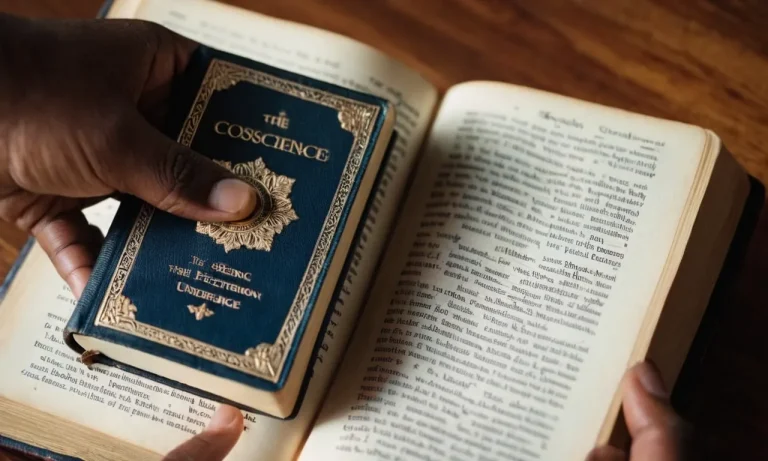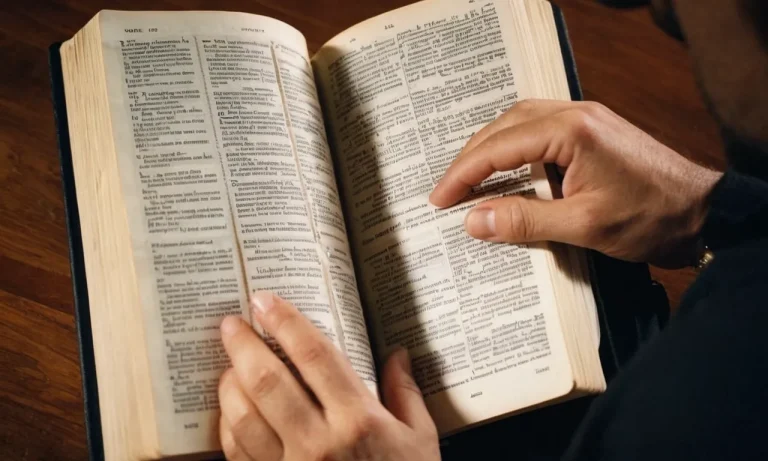Who Was The Woman Caught In Adultery In The Bible?
The story of the woman caught in adultery in the Bible has captivated readers for centuries. This powerful account found in John 8:1-11 provides important lessons about judgment, mercy and forgiveness.
If you’re short on time, here’s a quick answer to your question: The woman caught in adultery in John 8:1-11 is unnamed in Scripture. However, much speculation has arisen over her identity.
In this comprehensive article, we will examine the details of this passage, what we can know about this woman, the lessons learned from her story, and the significance of her experience with Jesus.
The Story of the Woman Caught in Adultery
The Account in John 8:1-11
The story of the woman caught in adultery is found in John 8:1-11. This dramatic account takes place at the temple in Jerusalem, where Jesus was teaching a crowd. The Pharisees and teachers of the law bring a woman who had been caught in adultery before Jesus and tell him that the Mosaic Law commands that she be stoned (Leviticus 20:10).
They were using this situation to try to trap Jesus into contradicting the Law so they could accuse him.
Jesus responds with wisdom, saying “Let any one of you who is without sin be the first to throw a stone at her.” One by one, the woman’s accusers leave, as they are convicted by their own consciences. Soon, only Jesus and the woman remain. Jesus asks her, “Woman, where are they?
Has no one condemned you?” She replies that no one remains to condemn her. Jesus mercifully tells her that he does not condemn her either, but that she should leave her life of sin.
The Woman’s Predicament
This woman found herself in a frightening predicament. She had been caught in the act of adultery, which was a grievous sin under the Law of Moses which merited the death penalty. She was likely dragged out of bed and paraded naked before this angry mob into the temple courts.
The text gives no further details about her specific situation.
The fact that the religious leaders only brought the woman and not the man involved hints that this situation may have been a trap or set-up designed to place Jesus into a dilemma. The Law required both parties in adultery to be stoned, yet the man was conspicuously absent.
The woman was exploited, alone and defenseless before this mob.
Jesus handled the situation with great wisdom, conviction, authority and mercy. He did uphold the sanctity of marriage by warning the woman to leave her lifestyle of sin. Yet he simultaneously extended her grace and a new start on life.
Ultimately Jesus rescued this woman from certain death to give her another chance.
What the Bible Reveals About the Woman
She Remains Unnamed
The woman caught in adultery in John 8:1-11 is not named in the biblical account. This reflects common practice in biblical times, when women in general were rarely named even when playing an important role in a narrative. Her anonymity likely also stems from the shameful nature of the situation.
Though unnamed, the woman’s story has still gripped readers for two millennia. As 20th century writer Madeleine L’Engle expressed: “Her name is not given. She is just a woman, every woman who has ever had to hide her sin until self-righteous accusers dragged her into the fierce light of day.”
Speculation About Her Identity
Some have speculated that the unnamed woman might have been Mary Magdalene, who is introduced just a few verses earlier (John 7:37-38). But most scholars dismiss this idea, since there are no clear textual links between the two women.
Attempts to equate various unnamed women in the Gospels with Mary Magdalene often reveal more about interpreters’ assumptions than about the biblical text itself.
More creatively, Scottish minister William Barclay imagined the woman as someone “whom some unhappiness drove to solace in forbidden things.” He pictured her finding momentary consolation in a stranger’s arms before her accusers burst in.
Barclay’s vivid scenario highlights the likelihood that more complex personal dynamics lurked beneath the sparing details supplied in the Gospel narrative.
In the end, the woman’s namelessness serves to make her story more universal. The notable 19th century abolitionist and women’s rights activist Sarah Grimké once declared: “No matter who the woman was, her rescue from violence by the divine Savior sends a powerful message down through the centuries.”
Lessons Learned from the Woman’s Story
Confronting Hypocrisy and Judgmentalism
The story of the woman caught in adultery provides a powerful example of confronting hypocrisy and judgmentalism. The religious leaders who brought the woman to Jesus were trying to trap him, not seeking true justice.
As Jesus pointed out, “Let any one of you who is without sin be the first to throw a stone at her” (John 8:7). His response reminds us that we all make mistakes and are in need of grace. Rather than judging others, we should examine our own hearts and lives.
The crowds drifted away as Jesus confronted their hypocrisy, leaving the woman alone with him. We too must beware of judging others harshly while ignoring our own flaws and sins.
The Power of Mercy and Forgiveness
This story also beautifully illustrates the power of mercy and forgiveness. The woman had sinned gravely, but Jesus did not condemn her. Instead, he showed her grace and commanded her to “go now and leave your life of sin” (John 8:11).
Though she deserved punishment, Jesus offered her restoration and new life. This reflects the boundless mercy God offers each of us. No matter what we’ve done, we can receive forgiveness and a new beginning through Christ.
As those shown such mercy, we must extend that same grace to others, overcoming the human tendency to judge and condemn. We’re all in need of forgiveness.
Jesus’ Response and Treatment of Women
Moreover, Jesus’ treatment of the woman caught in adultery models his compassionate and countercultural response to women. In a society where women were often oppressed, exploited and discarded, Jesus saw this woman’s humanity. Though guilty, she was not worthless in his eyes.
He defended her against condemnation and offered her dignity. Jesus’ respectful, gentle treatment of women appears throughout the Gospels. He engaged them in deep theological discussions, defended them, healed them, and welcomed their support.
Though radical for his time, Jesus affirmed women as equally valuable and capable of faithfulness and spiritual leadership. As Christ-followers, we must reflect his kingdom values in how we treat and view women.
The Significance of Her Story
A Portrait of Grace
The story of the woman caught in adultery (John 8:3-11) offers a profound portrait of God’s grace and forgiveness. This unnamed woman had been caught in the act of adultery, a grave sin punishable by stoning according to Mosaic law.
Yet when she was brought before Jesus, He did not condemn her but showed compassion. “Let any one of you who is without sin be the first to throw a stone at her,” Jesus told the crowd (v. 7). One by one, her accusers left.
With no one left to condemn her, Jesus told the woman, “Then neither do I condemn you…Go now and leave your life of sin” (v. 11).
Jesus demonstrated radical grace, extending forgiveness rather than judgment. His compassion reflects God’s heart for sinners – He “did not come to condemn the world, but to save the world” (John 3:17). As 1 Timothy 1:15 states, “Christ Jesus came into the world to save sinners.”
Though deserving condemnation for her adultery, Jesus offered her grace, redemption, and a new beginning instead.
This account captures the essence of the gospel message. All have sinned and face God’s judgment, yet God loves sinners so deeply that He offers forgiveness and restoration through Christ (Romans 3:23; 6:23). This woman encountered divine grace firsthand through Jesus.
Her life illustrates that no matter one’s past, God accepts, forgives, and transforms all who humbly receive His mercy.
An Example of Compassion
The way Jesus handled this woman’s situation sets a poignant example of compassion. The teachers of the law and Pharisees saw her only as a sinner deserving punishment for breaking the law. Jesus looked deeper, recognizing her as a human being created in God’s image.
He treated her with dignity, refusing to condemn her and jeopardize her life over her moral failure (John 10:10).
Jesus modeled a compassionate response toward sin – not minimizing the gravity of sin, but also not minimizing the value of the sinner. Ephesians 4:32 instructs believers, “Be kind and compassionate to one another, forgiving each other.”
Though admonishing the woman to leave her life of sin, Jesus did so gently, emphasizing forgiveness and restoration over retribution.
This passage reminds believers to evaluate their own hearts before condemning other people’s sins (Matthew 7:1-5). Only the sinless Son of God had the authority to condemn her lifestyle, yet He showed mercy instead.
The Scriptures compel Christians to “speak the truth in love” (Ephesians 4:15), following Christ’s pattern of conveying hard truths with grace and compassion.
Conclusion
The account of the woman caught in adultery provides a profound look at Jesus’ compassion, wisdom and grace. While her identity remains a mystery, her experience illuminates timeless truths about human nature, justice, forgiveness and redemption.
Jesus’ gentle treatment of this woman continues to inspire hearts centuries later, reminding us of the life-changing power of mercy and the call to follow Christ’s example.








